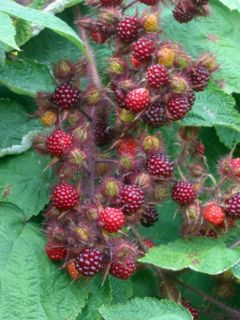Rubus phoenicolasius
| Rubus phoenicolasius subsp. var. | Wineberry, Japanese wineberries | |||||||||||||||||||||||||||||||||||||||||||||||||||||||
|---|---|---|---|---|---|---|---|---|---|---|---|---|---|---|---|---|---|---|---|---|---|---|---|---|---|---|---|---|---|---|---|---|---|---|---|---|---|---|---|---|---|---|---|---|---|---|---|---|---|---|---|---|---|---|---|---|

|
|
| ||||||||||||||||||||||||||||||||||||||||||||||||||||||
| ||||||||||||||||||||||||||||||||||||||||||||||||||||||||
The wineberry (Rubus phoenicolasius), a type of raspberry, grows wild in the eastern part of the United States. The heart-shaped leaves grow in groups of three and are white underneath. The canes have fine, red thorns, which appear much like red hair. The calyx (covering the fruit until it is ripe) is also red and hairy. The delicate fruits are slightly tart and ripen to a deep red in late June to early July.
New plants are formed from the tips of existing canes touching the ground. They enjoy moist soil and grow near and within wooded areas. They are considered invasive in some areas.[1]
They are also called Wine raspberries and Japanese wineberries. Despite the name, they are no more or less suited for winemaking.
Wineberry is also a tree endemic to New Zealand.
| Standard Cyclopedia of Horticulture |
|---|
|
Rubus phoenicolasius, Maxim. Wineberry. Fig. 3492. Canes long and recurving, furnished with straight, weak prickles and densely clothed with red-brown glandular hairs, prop, by "tips:" lfts. usually 3, broad-ovate to round-ovate, apiculate-toothed and sometimes indistinctly lobed at top, white-tomentose beneath: fls. in dense, small, shaggy-haired clusters which spring from the uppermost axils and form a large, loose, leafy panicle; petals shorter than the long, bristly calyx-lobes, the latter enlarging after flowering and inclosing the growing frs. in a bur but spreading apart as the fr. matures: fr. usually small and soft, cherry-red, acid or usually insipid. Japan and China.—Interesting as an ornamental plant, and also recommended for its fr. In the N. it often kills to the ground, but the strong young recurving canes and white- bottomed foliage make it a handsome plant. Sparingly run wild in the E. U. S.
|
Cultivation
Propagation
Pests and diseases
Varieties
Gallery
-
photo 1
-
photo 2
-
photo 3
References
- Standard Cyclopedia of Horticulture, by L. H. Bailey, MacMillan Co., 1963
External links
- w:Rubus phoenicolasius. Some of the material on this page may be from Wikipedia, under the Creative Commons license.
- Rubus phoenicolasius QR Code (Size 50, 100, 200, 500)
